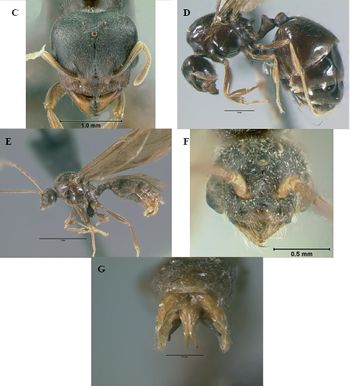Carebara alperti
| Carebara alperti | |
|---|---|

| |
| Scientific classification | |
| Kingdom: | Animalia |
| Phylum: | Arthropoda |
| Class: | Insecta |
| Order: | Hymenoptera |
| Family: | Formicidae |
| Subfamily: | Myrmicinae |
| Tribe: | Crematogastrini |
| Genus: | Carebara |
| Species: | C. alperti |
| Binomial name | |
| Carebara alperti Fernández, 2010 | |
A specimen from Sabah was found in a dead branch.
Identification
Fernandez (2010) - This species can be differentiated from other Carebara by the combination of the following traits: eyes present, promesonotum strongly convex, propodeum unarmed and propodeal lobes small. The presence of eyes links this species with the Carebara concinna group and the propodeum with the Carebara escherichi group. The promesonotum clearly convex appears as unique in Carebara. This species is placed, provisionally, in his own species group.
Distribution
Latitudinal Distribution Pattern
Latitudinal Range: 15.72932° to 13.3047°.
| North Temperate |
North Subtropical |
Tropical | South Subtropical |
South Temperate |
- Source: AntMaps
Distribution based on Regional Taxon Lists
Indo-Australian Region: Malaysia, Philippines (type locality).
Distribution based on AntMaps
Distribution based on AntWeb specimens
Check data from AntWeb
Countries Occupied
| Number of countries occupied by this species based on AntWiki Regional Taxon Lists. In general, fewer countries occupied indicates a narrower range, while more countries indicates a more widespread species. |

|
Estimated Abundance
| Relative abundance based on number of AntMaps records per species (this species within the purple bar). Fewer records (to the left) indicates a less abundant/encountered species while more records (to the right) indicates more abundant/encountered species. |

|
Biology
Castes
Nomenclature
The following information is derived from Barry Bolton's Online Catalogue of the Ants of the World.
- alperti. Carebara alperti Fernández, 2010: 193, figs. 1A-1G (w.q.m.) PHILIPPINES (Negros).
- Type-material: holotype worker, 1 paratype worker, 1 paratype queen, 1 paratype male.
- Type-locality: holotype Philippines: Negros Oriental, Dumaguete, Horns of Negros, Camp Lookout, 10.ix.1948 (J.W. Chapman); paratypes with same data.
- Type-depositories: MCZC (holotype); ICNB, MCZC (paratypes).
- Distribution: Philippines (Negros).
Unless otherwise noted the text for the remainder of this section is reported from the publication that includes the original description.
Description
Worker
Holotype. HL 0.52 HW 0.48 SL 0.40 PW 0.30 WL 0.54 PL 0.19 PPL 0.10 GL 0.65 TL 2.04 CI 92 SI 83.
Head slightly longer than wide. Posterior cephalic border sinuous, lateral sides slightly convex. Mandibles conspicuous with four stout teeth. Median portion of clypeus bicarinate. Eyes with one ommatidium, situated anterior to cephalic midline. Antennae 11-segmented with a 2-segmented apical club. Scapes failing to reach the vertexal border in less than their maximum width.
Promesonotum, in profile, strongly convex. Propodeum convex and low, unarmed. Propodeal spiracle relatively small, circular, high and equidistant from propodeal border. Propodeal lobes small. Petiole with long peduncle and with a well-defined high node; petiolar spiracle half of petiolar length. Subpetiolar process absent. Postpetiole dorsally convex, lower than petiole. Postpetiole, in dorsal view, trapezoidal.
Sting well developed. Body smooth and shiny, except for mesopleura and sides of propodeum, which are foveated. Dorsum of petiole and postpetiole smooth and shining. Erect hairs absent, except for some few hairs in the last gastral tergum. Short apressed hairs sparse on body. Body dark brown, appendages lighter brown.
Queen
HL 1.35 HW 1.40 EL 0.38 ML 0.25 SL 0.75 WL 2.48 PL 0.73 PPL 0.55 GL 3.42 TL 8.78 CI 103 SI 54.
As typical myrmicine queen, although noticeable larger than worker. Head wider posteriorly, widest point near to occipital corner. Vertexal border with median concavity. Clypeal border evenly convex. Antenna segmented. Scapes short, widening distally. Ocelli well defined. Propodeum with two well-defined, strong spiniform process. Most of body strongly smooth and shining. Head with conspicuous longitudinal rugulae, except the central clypeal area. Front wing with marginal, first submarginal and first discoidal cells present and closed. Vein M ending near to wing margin. Very few erect hairs on head frons, and dorsal masticatory border of mandibles, sparsed erect hairs on mesosoma, petiole, postpetiole, and gaster (especially first tergum). Body dark brown; appendages, antennae, and mandibles brown.
Male
HL 0.80 HW 0.98 EL 0.38 ML 0.15 SL 0.18 WL 1.88 PL 0.60 PPL 0.38 GL 2.38 TL 6.19 CI 123 SI 18.
As typical myrmicine male. Mandibles with 5 well-defined teeth, decreasing in size from apex. Promesonotum convex in lateral view. Propodeum angulated in lateral view. Gonostylus pale, with dense pilosty of curved withish hairs; volsellae dark, elongated, ending in a rounded apices. Abundant white erect hairs on mandibles, clypeus, and gena, dense black erect short hairs on rest of head. Body dark brown, appendages, antennae, and mandibles brown.
Type Material
Holotype worker: Philippines, Negros Oriental, Dumaguete, Horns of Negros, Camp Lookout, 10 ix 1948, J. W. Chapman leg. No. JWC0002 (deposited in Museum of Comparative Zoology). Paratypes (same data): one worker (deposited in Insect Collection, Instituto de Ciencias Naturales), one queen and one male (deposited in Museum of Comparative Zoology).
Etymology
This species is dedicated in honor to the colleague Gary Alpert (MCZC), for their generosity and helping to the visiting myrmecologists in Cambridge, and for their kindly advice with the specimens collected and AutoMontage pictures.
References
References based on Global Ant Biodiversity Informatics
- Fernández F. 2010. A new species of Carebara from the Philippines with notes and comments on the systematics of the Carebara genus group (Hymenoptera: Formicidae: Myrmicinae). Caldasia 32: 191-203.


